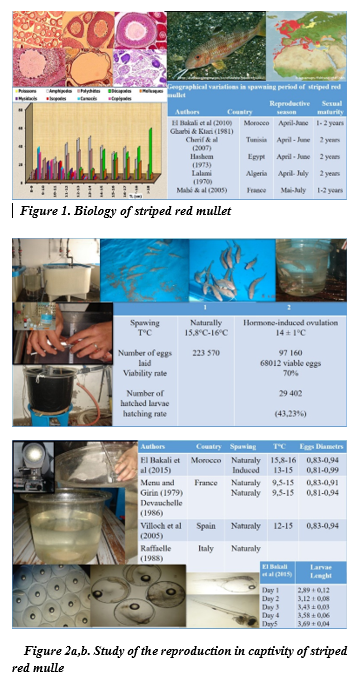STRIPED RED MULLET Mullus surmuletus L., 1758: STUDIES ON ITS AQUACULTURE POTENTIAL
This study was undertaken with the aim of studying the reproduction in captivity and the rearing of the first larval stages of the Striped red mullet in order to attempt a first evaluation of its susceptibility, as a candidate species for aquaculture.
Striped red mullet is a demersal fish occuring along the Atlantic coasts of Europe and Africa. In Morocco, striped red mullet is distributed along the entire Moroccan coastline. This species is considered to be among the most valuable and highly priced fish species because its high nutritional proprieties. Muscle is the main lipid storage organ. The lipid content varies between 2.60% and 22.27% of the dry weight of the muscle. The reproductive season extended from April to June. Sexual maturity occurs at 2 years of age. The mean fecundity is 757699,44±530274 oocytes. The prey items identified are Crustacean (Amphipods and Decapods) Polychaeta and Molluscs. Crustacean constituted more important group (%IRI = 70, 8).
To study the reproduction in captivity of striped red mullet, a batch of broodstock were captured from the wild and kept in an indoor rectangular tank of 1m³ under natural conditions of temperature (14-19.3°C), dissolved oxygen (5.9-7.4 mg/l), salinity (34-36 ‰). The red mullet spawn naturally in captivity when the water temperature is between 9,5 and 16°C. The spawning can also obtained by hormonal induction using 20 μg/kg LHRHa. The viability rate was over 70%. The incubation realized at 14°± 1°C. The hatching rate was 43.23 %. Larvae length at hatching was 2,89 ± 0,12 m, the yolk sac larvae had a total length of 1.15 ± 0.09 mm. With time, it decreased until disappeared completely around the fifth day. Larviculture was with green water. Rotifers were offered as first food 3 days after hatching. The larvae completed metamorphosis within a week after hatching.
The results of this study show that striped red mullet is an easy species for acclimatization to conditions of captivity, and it can even spawn during the same year of capture. Fecundity in captivity can reach 750,000 eggs per kilogram per year. After hatching the larvae are of good quality and present a good aptitude for rearing. These preliminary results are encouraging and merit further study to demonstrate the feasibility of producing striped red mullet fingerlings for stock enhancement or grow-out purposes. Keywords— Striped red mullet, reproduction in captivity, larviculture, marine Aquaculture, biology, Morocco.
